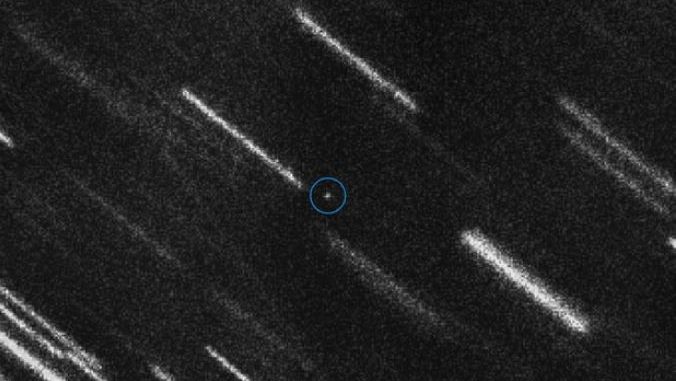
2012 TC4 is an asteroid measuring 20 meters in diameter earmarked to whiz past the Earth on Thursday, 12 October 2017 at an exceptionally close distance . The house sized space rock was discovered on October 4, 2012 by the Pan-STARRS observatory in Hawaii at a distance of 0.03 AU (4,500,000 km; 2,800,000 mi) from Earth. It was then re-discovered by Very Large Telescope (VLT) on 17 July 2017 at an exceptionally dim apparent magnitude of 26.8. The asteroid has an orbital period of 1.67 years and is given a rating of -3.66 on the Palermo scale, with a 1 in 630 chance of an Earth impact over the next hundred years.
This asteroid is of similar size to Meteor that exploded high over the skies of Chelyabinsk, Russia on 15 February 2013. The main difference being that we know this asteroid is coming unlike the event that unfolded at Chelyabinsk.
Closest Approach Timings
The asteroid will come closest to Earth around 05:42 UTC on October 12 below are times for various time zones
| TimeZone | Example Locations | Time | Day |
|---|---|---|---|
| PDT | LA, San Fransisco, Seattle | 22:42 | Wed, 11 Oct |
| MDT | Calgry, Denver, Salt Lake City | 23:42 | Wed, 11 Oct |
| CDT | Chicago, Mexico City, New Orleans | 00:42 | Thu, 12 Oct |
| EDT | Atlanta, Boston, Detroit, Miami, New York | 01:42 | Thu, 12 Oct |
| ART | Brasilia, Rio de Janeiro, Sao Paulo | 02:42 | Thu, 12 Oct |
| BRT | Buenos Aires, Kuwait City, San Juan | 02:42 | Thu, 12 Oct |
| UT | Universal Time | 05:42 | Thu, 12 Oct |
| BST | London, Guernsey, Jersey | 06:42 | Thu, 12 Oct |
| WAT/WEST | West Africa, Canary Is., Portugal | 06:42 | Thu, 12 Oct |
| CEST | Central Europe | 07:42 | Thu, 12 Oct |
| EAT | Addis Ababa, Nairobi | 08:42 | Thu, 12 Oct |
| EEAST | Eastern Europe | 08:42 | Thu, 12 Oct |
| IST | India | 11:12 | Thu, 12 Oct |
| JST | Japan | 14:42 | Thu, 12 Oct |
| AEST | Brisbane | 15:42 | Thu, 12 Oct |
| AEDT | Canberra, Melbourne, Sydney | 16:42 | Thu, 12 Oct |
Live Webcast
Watch the live webcast of the asteroid passing Earth via the Slooh Observatory’s live stream that was broadcast.
Possible Impact?
2012 TC4 is expected to reach closest approach to the Earth on Thursday, 12 October 2017 at a nail-bitingly close distance of around 27,300 miles. That is just outside the orbit of geostationary satellites. Thankfully, astronomers are confident that the asteroid will pass the Earth harmlessly and there is no cause for alarm. Detlef Koschny of ESA’s near-Earth objects research team said, “We know for sure that there is no possibility for this object to hit the Earth”. Likewise, Makoto Yoshikawa of the Japanese Aerospace Exploration Agency (JAXA) has said, “The distance is very small. But this distance does not mean the collision”.
Györgyey-Ries of the University of Texas says,
Although it has a large uncertainty along the orbit, it is much less than the radial uncertainty, so it just changes the time of the closest flyby. I would say based on this, that there is no chance of impact in 2017, but more observations could help to reduce the uncertainties.
Although the Earth’s safety is fairly certain for this pass, Earth’s gravity will significantly alter the asteroid’s trajectory before it exits the Earth-Moon system. Space agencies will no doubt be keeping a keen eye on the orbit of Asteroid 2012 TC4 for some time to come.
An Opportunity
This “asteroid flyby” or close approach for the use of a better phrase will provide an opportunity for professional astronomers to test their detection and tracking abilities of near Earth objects (or NEO’s). The object’s brightness is expected to peak at magnitude 12.9 at closest approach so it will also become observable to keen amateur astronomers alike.
Potentially Hazardous Asteroids
Potentially Hazardous Asteroids (PHA’s) are defined based on parameters that measure the asteroid’s potential to make threatening close approaches to the Earth. The International Astronomical Union’s Minor Planet Centre keeps a central catelogue of all known PHA’s. As of 10 September, 2017 there are currently 1803 PHA’s, none of which are known to to be on a collision course with Earth. NASA’s Planetary Defense section has an interesting frequently asked questions page all about Near Earth Asteroid detection, tracking and defense.

Leave a Reply